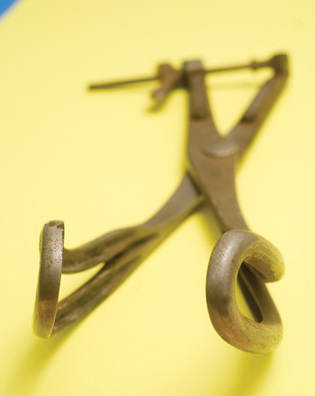 loading
loading
Arts & CultureObject lessonEarly obstetrics: for strong stomachs only Randi Hutter Epstein ’90MD is the author of Get Me Out: A History of Childbirth from the Garden of Eden to the Sperm Bank.  Mark MorosseBefore the modern forceps, obstetrical instruments like the Lusk Cephalotribe were designed to save the mother or baby—not both. View full image
For generations, giving birth was terrifying. Women knew that when complications arose, there was little to do but hope for survival. That began to change in the nineteenth century, when doctors developed lifesaving tools. But for the most part, those tools saved either mother or baby—not both. An assortment of these heavy metal obstetrical instruments is stored at the Cushing/Whitney Medical Library. The collection includes a variety of objects made to mangle a fetus lodged in the birth canal—easing its removal so doctors could save the mother from hemorrhage or sepsis. There are perforators (to pierce the skull), crochets (to hook and tear a dead fetus), and so-called blunt hooks (to tear off its head). The Lusk Cephalotribe (above), from the 1880s, looks like a gigantic pair of salad tongs with a long screw to clamp them together. Cephalotribe comes from the Greek words kephalos,head; and tribein, to bruise. “Bruise” is an understatement. The instruments were designed to crush the skulls of babies. As Dr. William Lusk, designer of this version of the tool and a midwife at Bellevue Hospital, put it in The Science and Art of Midwifery (1881), the cephalotribe’s advantage was that it could “crush in an instant the base and parietes of the fetal skull, forcing the brain from the orbits, the nostrils, and the mouth.” Whereas perforators sometimes flung pieces of bone into the mother’s birth canal, the curved blades of Lusk’s cephalotribe cupped the crushed head and prevented fractured bits of skull from “inflicting injury upon the soft parts of the mother.” Lusk called it a “crusher and a tractor”—meaning it held the skull tightly so the fetus would not slip. As gruesome as the cephalotribe was, there was some good in its brutality. Not only did it save women who would otherwise have died in childbirth, but the instrument also paved the way for forceps that allowed both mother and child to live. Around the same time Lusk was peddling his cephalotribe, doctors popularized the modern forceps, with curved blades that looked like the Lusk’s but allowed the baby to slide out with its skull intact. Much of the difference was about technique: doctors had to learn how much pressure it took to grab the head without crushing it. As is the case with many medical devices, the forceps, initially hailed as a breakthrough, would later be criticized. The controversies over overuse of forceps simmered for decades, only to be replaced with the controversy over increasing rates of cesarean sections. Amid these heated arguments, it’s worth remembering that obstetrics has come a long way since the nineteenth century. It’s a good thing the Lusk Cephalotribe is stored at a Yale library and no longer in a doctor’s office.
The comment period has expired.
|
|